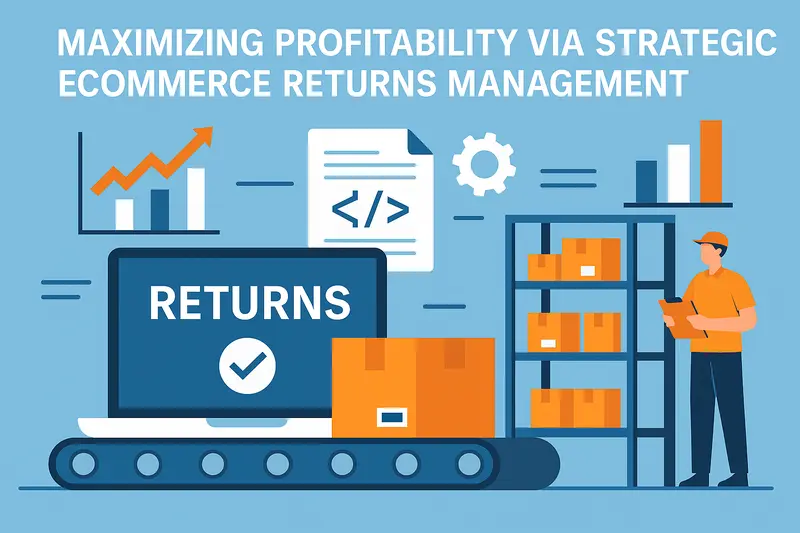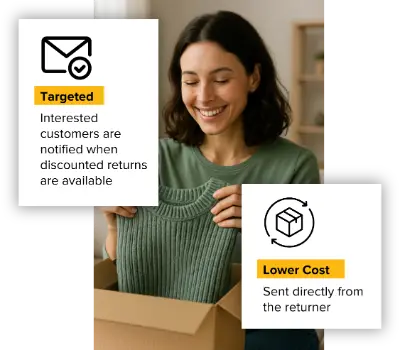Maximizing Profitability Through Strategic Ecommerce Returns Management

Last updated on October 06, 2025

Let’s face it: ecommerce returns management can feel like a headache. But the reality is, returns are an inevitable part of running an online business. Customers expect the ability to return products that aren’t what they wanted or don’t fit. So while it’s easy to see returns as a necessary evil that can seriously eat into your profit margins, they’re also necessary for customer satisfaction, which is what is needed to encourage the customer to convert in the first place, and then keep coming back to buy more. So a flexible returns policy increases brand affinity so that you can maximize lifetime customer value over the long term.
According to industry stats, returns can account for 20-30% of total sales, with some sectors like fashion seeing returns as high as 40%. For businesses that are already operating with thin margins, these figures are alarming.
And here’s where things get a little worse. It’s not just about reverse logistics (a fancy word for “shipping stuff back”) or the cost of restocking. Returns affect other parts of your business too, like the lost revenue from inventory that can’t be resold at full price, and all the people and tech you need just to handle the returns. It’s like running an entirely separate operation within your ecommerce business that doesn’t generate any revenue. This added layer of returns management in ecommerce can feel like a costly premium, but it’s essential to keep customers satisfied.
The good news is that if you handle them intelligently, returns can actually become a profit-boosting machine. Sounds too good to be true? Well, not really. You just need to rethink how you manage them. Honestly, I’ve seen businesses reduce their return-related headaches simply by adding a little tech, some smarter workflows, and a bit of focus. Let’s look at how a more strategic approach to returns management can turn them into an efficiency and profitability engine.
Streamlining Returns to Improve Profit Margins
One of the first steps to maximizing profitability is to streamline returns processing. This can make a world of difference. When customers send stuff back, it’s not just about the return label. A lot is happening behind the scenes: you’ve got to receive the product, inspect it (is it damaged?), restock it (add it to inventory and reshelve it), and then process the refund, store credit, or exchange. The process is time and resource-intensive, besides possibly losing the value of the returned item.
One effective strategy for streamlining returns is investing in returns management software. It’s like handing your returns process over to a super-efficient robot that doesn’t get tired. These systems can automate and optimize various steps in the returns process, cutting down on the manual work and speeding up the process. For example, a company might use software to automatically generate return labels, track where the returned items are, and even update customers about the status of their returns, all without bothering your customer service team. The result? You save substantial time and money (time is money) and you reduce the risk of errors that could lead to delays or incorrect refunds.
Make Returns Profitable, Yes!
Cut shipping and processing costs by 70% with our patented peer-to-peer returns solution. 4x faster than traditional returns.
See How It WorksLet’s say you’re running a fashion brand. When a customer returns a pair of jeans, the returns management software can automatically check if it’s eligible for return, create an RMA (return merchandise authorization), suggest exchange options that help retain revenue, create the return shipping label, and process the temporary inventory adjustment. The customer gets a smoother experience, on their schedule, and you reduce manual mistakes and inefficiencies that used to increase your operational costs.
Plus, the automation doesn’t just save time, it helps you get the product back into your inventory faster, which increases the likelihood that it will be resold. This means you lose less revenue from items that are just sitting around in limbo. You’re also making smarter use of your warehouse space, so no more wasted storage for returns that are clogging up the system. Think of it like getting your closet organized, everything has a place, and you don’t have to trip over a pile of returns.
Leveraging Data to Predict and Prevent Returns
Now, let’s talk about data. It’s a goldmine for improving your returns process, and its significance cannot be overstated. If you can figure out why items are getting returned in the first place, you can stop some of those returns from happening altogether. It’s all about moving from a reactive approach (waiting for returns to happen) to a proactive one (getting ahead of them before they even happen).
This is where predictive analytics comes in handy; you could look at past returns data combined with customer reviews to spot patterns and make adjustments accordingly. The goal is to eliminate a large percentage of your returns altogether.
A practical example is in fashion, a category where return rates can be high due to fit and size issues because customers are buying items without the benefit of being able to try them on first. If your system knows a customer usually buys a medium but has returned large items before, it can suggest the right fit from the get-go. If customers keep returning size 8 of a particular shoe style because they’re too tight, you can adjust the sizing chart, or maybe update the product descriptions to give more details about fit. This could reduce the likelihood of future customers returning the size 8 shoes for fit issues. That’s fewer returns and more happy customers, which is a win for improving profitability.
And here’s something you might not have thought about: you can also use your data to identify which customers tend to return things often, and you can take steps to figure out why and make the necessary adjustments. Maybe they didn’t fully understand the product descriptions, or the quality didn’t meet expectations. Addressing these issues means you can reduce returns in the first place, saving you from doing the same work over and over.
Of course, if you just have serial returners taking advantage of your flexible return policy, predictive analytics can help you identify them and either correct the behavior, disallow future returns, or block them altogether.
Integrating Return Solutions into the Broader Ecommerce Strategy
Here’s a big one: returns shouldn’t just be a separate task that you’re trying to fix on the side. To maximize profitability and make the most out of returns optimization, you have to integrate it into your broader ecommerce strategy. Think of it like making your returns process part of the whole picture: inventory management, customer service, and even marketing (think: Zappos, Amazon, Nordstrom). Everything should work together.
For example, you could sync your inventory management system with your returns process so that when an item is returned, available stock gets updated in real-time. This ensures that returned items are either restocked or removed from inventory if they are unsellable, avoiding situations where a business continues to sell inventory that’s no longer available or no longer in sellable condition.
Similarly, providing easy-to-access self-service return portals that are tightly integrated with your ecommerce platform can reduce the burden on customer service teams and enhance the customer experience. Return portals eliminate the need to contact anyone at all, making the whole experience smoother. You can set rules and define when returns are automatically approved, or suggest exchanges or returns for more store credit than the full refund value, potentially retaining the sale and customer. This allows customer service teams to focus on resolving the tougher issues that require a human rather than dealing with standard back-and-forth emails.
No More Return Waste
Help the planet and your profits—our award-winning returns tech reduces landfill waste and recycles value. Real savings, No greenwashing!
Learn About Sustainable ReturnsSummary
Here’s the takeaway: returns are inevitable in ecommerce, but they don’t have to be the profit-killer you think they are, and they don’t have to be a drain on your patience and emotions. By streamlining the returns process, using data to get ahead of problems, and integrating returns into your broader business operations, you can actually save time and money while increasing customer satisfaction and brand reputation, which encourages future transactions (higher lifetime customer value). Read another way: with the right approach to returns management, you can lower your cost of doing business and make more money while you’re at it.

Turn Returns Into New Revenue


